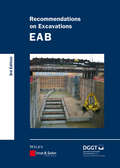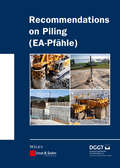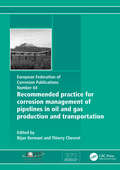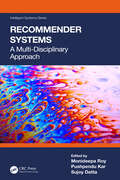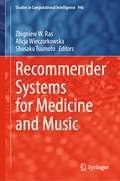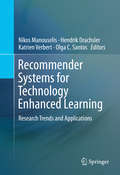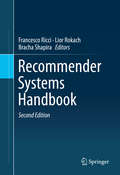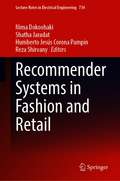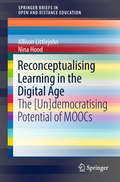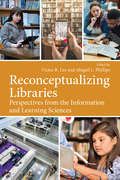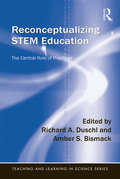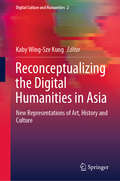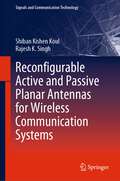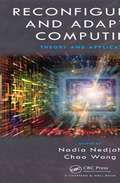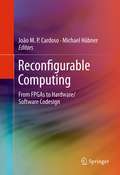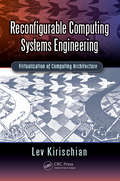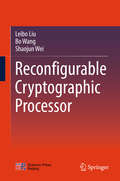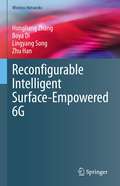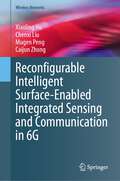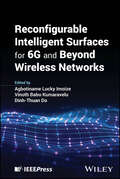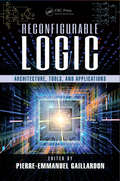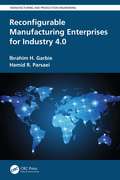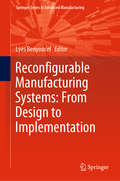- Table View
- List View
Recommendations on Excavations 3e
by Alan Johnson Deutsche Gesellschaft für Geotechnik e.V. / German Geotechnical SocietyWith the issue of these recommendations, which have the character of a standard, the "Building Excavations" working group of the German Geotechnics Association (DGGT) aims to provide assistance with the design and structural calculation of excavation support works.The introduction of the Eurocodes for building control purposes made necessary a revision of the previous edition of the recommendations to comply with the requirements of DIN EN 1997-1:2009 together with the national annex DIN 1997-1/NA:2010-12 and the supplementary regulations of DIN 1054:2010-12. All recommendations were thoroughly checked, revised where necessary and adapted to new knowledge. Chapter 10 "Building excavations in water" was substantially revised. Due to the progress of development of measurement instruments and the more stringent requirements, Chapter 14 "Instrumentation for the monitoring and supervision of building excavation support works" was formulated completely anew. The recommendations of the working group "Building Excavations" should be of assistance,- to simplify the design and structural calculation of excavation support works,- to harmonise loading assumptions and calculation procedures,- to ensure the structural stability of excavation support works and their individual elements and- to improve the cost-effectiveness of excavation support works.
Recommendations on Piling (EA Pfähle)
by Alan Johnson Deutsche Gesellschaft für Geotechnik e.V. / German Geotechnical SocietyThis handbook provides a complete and detailed overview of piling systems and their application. <P><P>The design and construction of piled foundations is based on Eurocode 7 and DIN 1054 edition 2010 as well as the European construction codes DIN EN 1536 (Bored piles), DIN EN 12699 (Displacement piles) and DIN EN 14199 (Micropiles). These recommendations also deal with - categorisation of piling systems, - actions on piles from structural loading, negative skin friction and side pressure, - pile resistances from static and dynamic pile test loading as well as extensive tables with the pile load-bearing capacity of nearly all piling systems based on values from practical experience, - pile groups, - performance of static and dynamic test loading and integrity tests, - load-bearing behaviour and verifications for piles under cyclical, dynamic and impact actions - quality assurance for construction. An appendix with numerous calculation examples completes the work. As part of the approval procedure for offshore wind energy structures, the Federal Office for Shipping and Hydrography (BSH) demands verifications according to the new Chapter 13 ("Load-bearing behaviour and verifications for piles under cyclical, dynamical and impact actions") of the EA Pfähle (the recommendations of the Piling working group - 2nd edition), which deals with external pile resistance for the foundations of offshore wind energy structures and the types of verifications to be provided under cyclical actions. The publication of the EA-Pfähle recommendations by the Piling working group of the German Society for Geotechnics (DGGT), which works with the same members as the piling standards committee NA 00-05-07, is intended to provide assistance for engineers active in the design, calculation and construction of piled foundations. The recommendations can thus be considered as rules of the technology and as a supplement to the available codes and standards.
Recommended Practice for Corrosion Management of Pipelines in Oil & Gas Production and Transportation (European Federation Of Corrosion Publications)
by Bijan KermaniFirst Published in 2017. Pipeline integrity is key to maintaining operational success, safety and security and minimising harm to the environment. Corrosion is a dominant contributory factor to failures, leaks and integrity threats in pipelines. Therefore, its optimum control within an integrity management framework is paramount for the cost-effective design of facilities and ensuring continued, uninterrupted and safe operations within the expected design life. This recommended practice (RP) is a compendium of current best practices and state-of-the-art knowledge by major operators, engineering contractors and service companies involved in hydrocarbon pro-duction and transportation. The RP incorporates some minimum operational requirements and practices to ensure that when man-aging corrosion in pipelines, fundamental principles are followed. It covers management of corrosion for pipelines carrying hydrocarbons, injection water and/or produced water from design to decommissioning. It is structured to follow the logical steps of a basic corrosion management process and makes references to relevant and available international standards and/or recommended practices. It is intended for use by personnel from the petroleum industry having knowledge of corrosion and materials. It is hoped that this RP will prove to be a key reference document for engineers, suppliers and con-tractors working in the oil and gas industry, paving the way for corrosion-free operation of pipelines with the ultimate goal of improving safety, security and minimising the impact on the environment
Recommender Systems
by Dietmar Jannach Markus Zanker Alexander Felfernig Gerhard FriedrichIn this age of information overload, people use a variety of strategies to make choices about what to buy, how to spend their leisure time, and even whom to date. Recommender systems automate some of these strategies with the goal of providing affordable, personal, and high-quality recommendations. This book offers an overview of approaches to developing state-of-the-art recommender systems. The authors present current algorithmic approaches for generating personalized buying proposals, such as collaborative and content-based filtering, as well as more interactive and knowledge-based approaches. They also discuss how to measure the effectiveness of recommender systems and illustrate the methods with practical case studies. The final chapters cover emerging topics such as recommender systems in the social web and consumer buying behavior theory. Suitable for computer science researchers and students interested in getting an overview of the field, this book will also be useful for professionals looking for the right technology to build real-world recommender systems.
Recommender Systems: A Multi-Disciplinary Approach (Intelligent Systems)
by Monideepa Roy Pushpendu Kar Sujoy DattaRecommender Systems: A Multi-Disciplinary Approach presents a multi-disciplinary approach for the development of recommender systems. It explains different types of pertinent algorithms with their comparative analysis and their role for different applications. This book explains the big data behind recommender systems, the marketing benefits, how to make good decision support systems, the role of machine learning and artificial networks, and the statistical models with two case studies. It shows how to design attack resistant and trust-centric recommender systems for applications dealing with sensitive data. Features of this book: Identifies and describes recommender systems for practical uses Describes how to design, train, and evaluate a recommendation algorithm Explains migration from a recommendation model to a live system with users Describes utilization of the data collected from a recommender system to understand the user preferences Addresses the security aspects and ways to deal with possible attacks to build a robust system This book is aimed at researchers and graduate students in computer science, electronics and communication engineering, mathematical science, and data science.
Recommender Systems for Medicine and Music (Studies in Computational Intelligence #946)
by Zbigniew W. Ras Alicja Wieczorkowska Shusaku TsumotoMusic recommendation systems are becoming more and more popular. The increasing amount of personal data left by users on social media contributes to more accurate inference of the user’s musical preferences and the same to quality of personalized systems. Health recommendation systems have become indispensable tools in decision making processes in the healthcare sector. Their main objective is to ensure the availability of valuable information at the right time by ensuring information quality, trustworthiness, authentication, and privacy concerns. Medical doctors deal with various kinds of diseases in which the music therapy helps to improve symptoms. Listening to music may improve heart rate, respiratory rate, and blood pressure in people with heart disease. Sound healing therapy uses aspects of music to improve physical and emotional health and well-being. The book presents a variety of approaches useful to create recommendation systems in healthcare, music, and in music therapy.
Recommender Systems for Technology Enhanced Learning
by Nikos Manouselis Hendrik Drachsler Katrien Verbert Olga C. SantosAs an area, Technology Enhanced Learning (TEL) aims to design, develop and test socio-technical innovations that will support and enhance learning practices of individuals and organizations. Information retrieval is a pivotal activity in TEL and the deployment of recommender systems has attracted increased interest during the past years. Recommendation methods, techniques and systems open an interesting new approach to facilitate and support learning and teaching. The goal is to develop, deploy and evaluate systems that provide learners and teachers with meaningful guidance in order to help identify suitable learning resources from a potentially overwhelming variety of choices. Contributions address the following topics: i) user and item data that can be used to support learning recommendation systems and scenarios, ii) innovative methods and techniques for recommendation purposes in educational settings and iii) examples of educational platforms and tools where recommendations are incorporated.
Recommender Systems Handbook
by Francesco Ricci Lior Rokach Bracha ShapiraThis second edition of a well-received text, with 20 new chapters, presents a coherent and unified repository of recommender systems' major concepts, theories, methodologies, trends, and challenges. A variety of real-world applications and detailed case studies are included. In addition to wholesale revision of the existing chapters, this edition includes new topics including: decision making and recommender systems, reciprocal recommender systems, recommender systems in social networks, mobile recommender systems, explanations for recommender systems, music recommender systems, cross-domain recommendations, privacy in recommender systems, and semantic-based recommender systems. This multi-disciplinary handbook involves world-wide experts from diverse fields such as artificial intelligence, human-computer interaction, information retrieval, data mining, mathematics, statistics, adaptive user interfaces, decision support systems, psychology, marketing, and consumer behavior. Theoreticians and practitioners from these fields will find this reference to be an invaluable source of ideas, methods and techniques for developing more efficient, cost-effective and accurate recommender systems.
Recommender Systems in Fashion and Retail (Lecture Notes in Electrical Engineering #734)
by Nima Dokoohaki Shatha Jaradat Humberto Jesús Corona Pampín Reza ShirvanyThis book includes the proceedings of the second workshop on recommender systems in fashion and retail (2020), and it aims to present a state-of-the-art view of the advancements within the field of recommendation systems with focused application to e-commerce, retail, and fashion by presenting readers with chapters covering contributions from academic as well as industrial researchers active within this emerging new field. Recommender systems are often used to solve different complex problems in this scenario, such as product recommendations, or size and fit recommendations, and social media-influenced recommendations (outfits worn by influencers).
Reconceptualising Learning in the Digital Age: The [un]democratising Potential Of Moocs (SpringerBriefs in Education)
by Allison Littlejohn Nina HoodThis book situates Massive Open Online Courses and open learning within a broader educational, economic and social context. It raises questions regarding whether Massive Open Online Courses effectively address demands to open up access to education by triggering a new education order, or merely represent reactionary and unimaginative responses to those demands. It offers a fresh perspective on how we conceptualise learners and learning, teachers and teaching, accreditation and quality, and how these dimensions fit within the emerging landscape of new forms of open learning.
Reconceptualizing Libraries: Perspectives from the Information and Learning Sciences
by Victor R. Lee Abigail L. PhillipsReconceptualizing Libraries brings together cases and models developed by experts in the information and learning sciences to identify the potential for libraries to adapt and transform in the wake of new technologies for connected learning and discovery. Chapter authors explore the ways that the increased interest in the design research methods, digital media emphases, and technological infrastructure of the learning sciences can foster new collaborations and formats for education within physical library spaces. Models and case studies from a variety of library contexts demonstrate how library professionals can act as change agents and design partners and how patrons can engage with these evolving experiences. This is a timely and innovative volume for understanding how physical libraries can incorporate and thrive as educational resources using new developments in technology and in the learning sciences.
Reconceptualizing STEM Education: The Central Role of Practices (Teaching and Learning in Science Series)
by Richard A. Duschl Amber S. BismackReconceptualizing STEM Education explores and maps out research and development ideas and issues around five central practice themes: Systems Thinking; Model-Based Reasoning; Quantitative Reasoning; Equity, Epistemic, and Ethical Outcomes; and STEM Communication and Outreach. These themes are aligned with the comprehensive agenda for the reform of science and engineering education set out by the 2015 PISA Framework, the US Next Generation Science Standards and the US National Research Council’s A Framework for K-12 Science Education. The new practice-focused agenda has implications for the redesign of preK-12 education for alignment of curriculum-instruction-assessment; STEM teacher education and professional development; postsecondary, further, and graduate studies; and out-of-school informal education. In each section, experts set out powerful ideas followed by two eminent discussant responses that both respond to and provoke additional ideas from the lead papers. In the associated website highly distinguished, nationally recognized STEM education scholars and policymakers engage in deep conversations and considerations addressing core practices that guide STEM education.
Reconceptualizing the Digital Humanities in Asia: New Representations of Art, History and Culture (Digital Culture and Humanities #2)
by Kaby Wing-Sze KungThis book examines new forms of representation that have changed our perception and interpretation of the humanities in an Asian, and digital, context. In analyzing written and visual texts, such as the use of digital technology and animation in different works of art originating from Asia, the authors demonstrate how literature, history, and culture are being redefined in spatialized relations amid the trend of digitization. Research studies on Asian animation are in short supply, and so this volume provides new and much needed insights into how art, literature, history, and culture can be presented in innovative ways in the Asian digital world. The first section of this volume focuses on the new conceptualization of the digital humanities in art and film studies, looking at the integration of digital technologies in museum narration and cinematic production. The second section of the volume addresses the importance of framing these discussions within the context of gender issues in the digital world, discussing how women are represented in different forms of social media. The third and final section of the book explores the digital world’s impacts on people’s lives through different forms of digital media, from the electromagnetic unconscious to digital storytelling and digital online games. This book presents a novel contribution to the burgeoning field of the digital humanities by informing new forms of representation and interpretations, and demonstrating how digitization can influence and change cultural practices in Asia, and globally. It will be of interest to students and scholars interested in digitization from the full spectrum of humanities disciplines, including art, literature, film, music, visual culture, media, and animation, gaming, and Internet culture."This is a well-written book, and I enjoyed reading it. The first impression of the book is that it is very innovative - a down-to-the-earth academic volume that discusses digital culture."- Professor Anthony Fung, Professor, Director, School of Journalism and Communication, The Chinese University of Hong Kong "This book has contributed to the existing field of humanities by informing new forms of representation and interpretations, and how digitization may change cultural practices. There is comprehensive information on how the humanities in the digital age can be applied to a wide range of subjects including art, literature, film, pop music, music videos, television, animation, games, and internet culture."- Dr Samuel Chu, Associate Professor, The Faculty of Education, The University of Hong Kong
Reconfigurable Active and Passive Planar Antennas for Wireless Communication Systems (Signals and Communication Technology)
by Shiban Kishen Koul Rajesh K. SinghThis book presents state-of-the-art trends in reconfigurable active and passive planar antennas and their applications in wireless communication systems operating in the frequency band 5-6 GHz. Due to various key features such as multifunction antenna design, compactness, planar nature, and low cost, these technologies are becoming popular for current and future wireless applications. This book discusses different novel antenna designs and their working principles in detail. The modern and future wireless systems require wideband antennas to accommodate various channels in a single band or in separate bands. The carrier aggregation (CA) has been introduced in the modern wireless systems such as LTE-advanced systems and 5G./6G. In CA, a device can use several channels for transmission and reception. The used channels can exist in the same frequency band (intra-band CA) or in distinct bands (inter-band CA). To accommodate more channels, more bandwidth is required within the operating band. For portable devices, circularly polarized (CP) antennas are more advantageous over linearly polarized antennas since in CP antennas, there is low risk of misalignment and, hence encountering interference. Circularly polarized antenna also provides higher link reliability for the portable devices. To provide high data rates, more bandwidth is needed to accommodate more channels. Various multifunction, compact, and wideband antennas for plethora of applications are addressed in detail in this book. The scope of developing reconfigurable active antennas for application in beam switching, beam steering, wireless charging, security systems, etc., is described. This book concludes by giving glimpses of antenna requirements for future wireless communication systems.
Reconfigurable and Adaptive Computing: Theory and Applications
by Nadia Nedjah Chao WangReconfigurable computing techniques and adaptive systems are some of the most promising architectures for microprocessors. Reconfigurable and Adaptive Computing: Theory and Applications explores the latest research activities on hardware architecture for reconfigurable and adaptive computing systems.The first section of the book covers reconfigurable systems. The book presents a software and hardware codesign flow for coarse-grained systems-on-chip, a video watermarking algorithm for the H.264 standard, a solution for regular expressions matching systems, and a novel field programmable gate array (FPGA)-based acceleration solution with MapReduce framework on multiple hardware accelerators.The second section discusses network-on-chip, including an implementation of a multiprocessor system-on-chip platform with shared memory access, end-to-end quality-of-service metrics modeling based on a multi-application environment in network-on-chip, and a 3D ant colony routing (3D-ACR) for network-on-chip with three different 3D topologies.The final section addresses the methodology of system codesign. The book introduces a new software–hardware codesign flow for embedded systems that models both processors and intellectual property cores as services. It also proposes an efficient algorithm for dependent task software–hardware codesign with the greedy partitioning and insert scheduling method (GPISM) by task graph.
Reconfigurable Cellular Neural Networks and Their Applications (SpringerBriefs in Applied Sciences and Technology)
by Müştak E. Yalçın Tuba Ayhan Ramazan YeniçeriThis book explores how neural networks can be designed to analyze sensory data in a way that mimics natural systems. It introduces readers to the cellular neural network (CNN) and formulates it to match the behavior of the Wilson–Cowan model. In turn, two properties that are vital in nature are added to the CNN to help it more accurately deliver mimetic behavior: randomness of connection, and the presence of different dynamics (excitatory and inhibitory) within the same network. It uses an ID matrix to determine the location of excitatory and inhibitory neurons, and to reconfigure the network to optimize its topology. The book demonstrates that reconfiguring a single-layer CNN is an easier and more flexible solution than the procedure required in a multilayer CNN, in which excitatory and inhibitory neurons are separate, and that the key CNN criteria of a spatially invariant template and local coupling are fulfilled. In closing, the application of the authors’ neuron population model as a feature extractor is exemplified using odor and electroencephalogram classification.
Reconfigurable Computing
by Michael Hübner João M. CardosoAs the complexity of modern embedded systems increases, it becomes less practical to design monolithic processing platforms. As a result, reconfigurable computing is being adopted widely for more flexible design. Reconfigurable Computers offer the spatial parallelism and fine-grained customizability of application-specific circuits with the postfabrication programmability of software. To make the most of this unique combination of performance and flexibility, designers need to be aware of both hardware and software issues. FPGA users must think not only about the gates needed to perform a computation but also about the software flow that supports the design process. The goal of this book is to help designers become comfortable with these issues, and thus be able to exploit the vast opportunities possible with reconfigurable logic.
Reconfigurable Computing Systems Engineering: Virtualization of Computing Architecture
by Lev KirischianReconfigurable Computing Systems Engineering: Virtualization of Computing Architecture describes the organization of reconfigurable computing system (RCS) architecture and discusses the pros and cons of different RCS architecture implementations. Providing a solid understanding of RCS technology and where it’s most effective, this book: Details the architecture organization of RCS platforms for application-specific workloads Covers the process of the architectural synthesis of hardware components for system-on-chip (SoC) for the RCS Explores the virtualization of RCS architecture from the system and on-chip levels Presents methodologies for RCS architecture run-time integration according to mode of operation and rapid adaptation to changes of multi-parametric constraints Includes illustrative examples, case studies, homework problems, and references to important literature A solutions manual is available with qualifying course adoption. Reconfigurable Computing Systems Engineering: Virtualization of Computing Architecture offers a complete road map to the synthesis of RCS architecture, exposing hardware design engineers, system architects, and students specializing in designing FPGA-based embedded systems to novel concepts in RCS architecture organization and virtualization.
Reconfigurable Cryptographic Processor
by Shaojun Wei Bo Wang Leibo LiuThis book focuses on the design methods for reconfigurable computing processors for cryptographic algorithms. It covers the dynamic reconfiguration analysis of cryptographic algorithms, hardware architecture design, and compilation techniques for reconfigurable cryptographic processors, and also presents a case study of implementing the reconfigurable cryptographic processor “Anole” designed by the authors’ team. Moreover, it features discussions on countermeasures against physical attacks utilizing partially and dynamically reconfigurable array architecture to enhance security, as well as the latest trends for reconfigurable cryptographic processors. This book is intended for research scientists, graduate students, and engineers in electronic science and technology, cryptography, network and information security, as well as computer science and technology.
Reconfigurable Intelligent Surface-Empowered 6G (Wireless Networks)
by Hongliang Zhang Boya Di Lingyang Song Zhu HanThis book presents novel RIS-Based Smart Radio techniques, targeting at achieving high-quality channel links in cellular communications via design and optimization of the RIS construction. Unlike traditional antenna arrays, three unique characteristics of the RIS will be revealed in this book. First, the built-in programmable configuration of the RIS enables analog beamforming inherently without extra hardware or signal processing. Second, the incident signals can be controlled to partly reflect and partly transmit through the RIS simultaneously, adding more flexibility to signal transmission. Third, the RIS has no digital processing capability to actively send signals nor any radio frequency (RF) components. As such, it is necessary to develop novel channel estimation and communication protocols, design joint digital and RIS-based analog beamforming schemes and perform interference control via mixed reflection and transmission. This book also investigates how to integrate the RIS to legacy communication systems. RIS techniques are further investigated in this book (benefited from its ability to actively shape the propagation environment) to achieve two types of wireless applications, i.e., RF sensing and localization. The influence of the sensing objectives on the wireless signal propagation can be potentially recognized by the receivers, which are then utilized to identify the objectives in RF sensing. Unlike traditional sensing techniques, RIS-aided sensing can actively customize the wireless channels and generate a favorable massive number of independent paths interacting with the sensing objectives. It is desirable to design RIS-based sensing algorithms, and optimize RIS configurations. For the second application, i.e., RIS aided localization, an RIS is deployed between the access point (AP) and users. The AP can then analyze reflected signals from users via different RIS configurations to obtain accurate locations of users. However, this is a challenging task due to the dynamic user topology, as well as the mutual influence between multiple users and the RIS. Therefore, the operations of the RIS, the AP, and multiple users need to be carefully coordinated. A new RIS-based localization protocol for device cooperation and an RIS configuration optimization algorithm are also required. This book targets researchers and graduate-level students focusing on communications and networks. Signal processing engineers, computer and information scientists, applied mathematicians and statisticians, who work in RIS research and development will also find this book useful.
Reconfigurable Intelligent Surface-Enabled Integrated Sensing and Communication in 6G (Wireless Networks)
by Xiaoling Hu Chenxi Liu Mugen Peng Caijun ZhongAs the main trend and key enabling technology for next-generation wireless networks (i.e., 6G), integrated sensing and communication (ISAC) can effectively improve spectrum efficiency, hardware efficiency, and information processing efficiency. However, it faces several deficiencies, including limited coverage due to high-frequency signals and limited communication-sensing performance due to uncontrollable wireless environments. Reconfigurable intelligent surface (RIS) provides novel dimensions to address these deficiencies by intelligently manipulating the wireless propagation environment in an energy- and hardware-efficient manner. RIS-enabled ISAC is expected to comprehensively promote the multi-dimensional performance of 6G, such as communication capacity, sensing accuracy, and coverage. Nevertheless, to fully realize its potential, one needs to figure out the impacts of RIS on joint communication and sensing performance and tackle new technical challenges in beamforming design and signal processing. The goal of this book, therefore, is to deliver a thorough understanding of RIS-enabled ISAC from three perspectives: performance analysis, beamforming design, and signal processing. Specifically, the authors provide a brief introduction to RIS-enabled ISAC, including basic concepts, motivations, potential application scenarios, and an overview of the state-of-the-art research on RIS-enabled ISAC. The theoretical performance analytical frameworks of RIS-enabled ISAC and their corresponding results are also discussed. Based on this, several critical issues are identified and elaborated on, including signal processing technologies such as angle and Delay-Doppler information acquisition, and air interface technologies such as beamforming designs. Finally, the book concludes with future trends and open issues for further research.The book would be beneficial for researchers, graduate students, and industry professionals who wish to gain a comprehensive understanding of the latest developments and challenges in RIS-enabled ISAC. By providing insights into the potential of RIS-enabled ISAC and the technical challenges that need to be addressed, the book can aid in the development of practical solutions for next-generation wireless networks and contribute to the advancement of the field of wireless communications.
Reconfigurable Intelligent Surfaces for 6G and Beyond Wireless Networks
by Agbotiname Lucky Imoize Vinoth Babu Kumaravelu Dinh-Thuan DoNew insights into trends, deployments, applications, and associated benefits of reconfigurable intelligent surfaces (RIS) in emerging wireless communication systems Reconfigurable Intelligent Surfaces for 6G and Beyond Wireless Networks analyzes the design and applications of RIS in 6G and beyond, such as aiding efficient wireless signal transmission from the transmitter to the receiver while considering several practical constraints. In addition, the book offers advanced signal-processing algorithms to enable RIS applications in realistic environments and leverages advanced mathematical tools and machine learning algorithms to analyze RIS dynamics in evolving wireless networks. Written in an easy-to-understand format, this book addresses the need to design energy- and spectral-efficient RIS models to address several network issues, including interference, pathloss, delay, traffic outage, etc. It also discusses critical security and privacy issues affecting all stakeholders in the wireless ecosystem, providing practical deep learning-based solutions to address these problems appropriately. This book also addresses critical concepts, design principles, applications, and issues with RIS, shedding light on the recent progress and advancement in RIS-assisted wireless networks for 6G and beyond. With contributions from experts and researchers from across the globe, this invaluable resource includes information on: Emerging applications and potential use cases of reconfigurable intelligent surfaces in advanced wireless communication systemsChannel modeling and propagation measurements in RIS-based wireless communication systemsEnergy and spectral efficiency and rate fairness for RIS-aided multiuser massive MIMO systemsPerformance optimization of multiple RIS-assisted multiuser MIMO communication systemsAnalytical phase-shift and amplitude element optimization for energy-efficient active RIS-aided massive MIMO systemsPhysical layer security architecture and frameworks for RIS-aided wireless communication systemsRIS deployment in terrestrial and non-terrestrial wireless communication systemsApplication of AI and ML techniques for intelligent power control in RIS-empowered wireless communication systems Reconfigurable Intelligent Surfaces for 6G and Beyond Wireless Networks is an essential up-to-date reference on the subject for industry and academic researchers, scientists, and engineers in the fields of wireless communications, ICTs, MIMO, antennas, sensing, channel measurements, and modeling technologies, as well as engineers and professionals involved in RIS-assisted wireless networks.
Reconfigurable Logic: Architecture, Tools, and Applications (Devices, Circuits, and Systems)
by Pierre-Emmanuel GaillardonDuring the last three decades, reconfigurable logic has been growing steadily and can now be found in many different fields. Field programmable gate arrays (FPGAs) are one of the most famous architecture families of reconfigurable devices. FPGAs can be seen as arrays of logic units that can be reconfigured to realize any digital systems. Their high versatility has enabled designers to drastically reduce time to market, and made FPGAs suitable for prototyping or small production series in many branches of industrial products. In addition, and thanks to innovations at the architecture level, FPGAs are now conquering segments of mass markets such as mobile communications.Reconfigurable Logic: Architecture, Tools, and Applications offers a snapshot of the state of the art of reconfigurable logic systems. Covering a broad range of architectures, tools, and applications, this book: Explores classical FPGA architectures and their supporting tools Evaluates recent proposals related to FPGA architectures, including the use of network-on-chips (NoCs) Examines reconfigurable processors that merge concepts borrowed from the reconfigurable domain into processor design Exploits FPGAs for high-performance systems, efficient error correction codes, and high-bandwidth network routers with built-in security Expounds on emerging technologies to enhance FPGA architectures, improve routing structures, and create non-volatile configuration flip-flops Reconfigurable Logic: Architecture, Tools, and Applications reviews current trends in reconfigurable platforms, providing valuable insight into the future potential of reconfigurable systems.
Reconfigurable Manufacturing Enterprises for Industry 4.0 (Manufacturing and Production Engineering)
by Ibrahim H. Garbie Hamid ParsaeiThe objective of this book is to support readers facing the urgency, challenges, analysis, and methodologies to reconfiguration. It presents a comprehensive framework for reconfiguring manufacturing enterprises and provides a set of valuable conceptual frameworks and methodologies for analyzing, evaluating, and assessing reconfiguration indices. This book offers practical guidance for implementing the Fourth Industrial Revolution (Industry 4.0). It presents open-ended problems pertaining to the concepts covered in the book and provides a new approach for reconfiguring industrial systems. Not only is this book for industrialists and academics, it will also appeal to undergraduate and graduate students studying industrial, mechanical, and manufacturing engineering. Scholars and practitioners in operations management will also find this book of interest.
Reconfigurable Manufacturing Systems: From Design to Implementation (Springer Series in Advanced Manufacturing)
by Lyes BenyoucefThis book develops innovative techniques from operational research and management science for the design and implementation of a reconfigurable manufacturing system (RMS), and subsequently analyzes and assesses their performance. A reconfigurable manufacturing system (RMS) is a paradigm that can address many of the challenges posed by the modern market. Accordingly, substantial research is now being conducted on RMS, focusing on various levels of decision-making (strategic, tactical and operational). However, as a relatively new research area, there are still only very few books and articles available on reconfigurable manufacturing system design and management. In addition to filling that gap, this book provides a forum for investigating, exchanging ideas on, and disseminating the latest advances in the broad area of RMS applications in today’s industry. Gathering contributions by experts from academia, industry and policy-making, it represents an essential contribution to the existing literature on manufacturing and logistics in general and industry 4.0 in particular.
